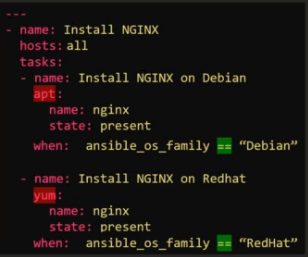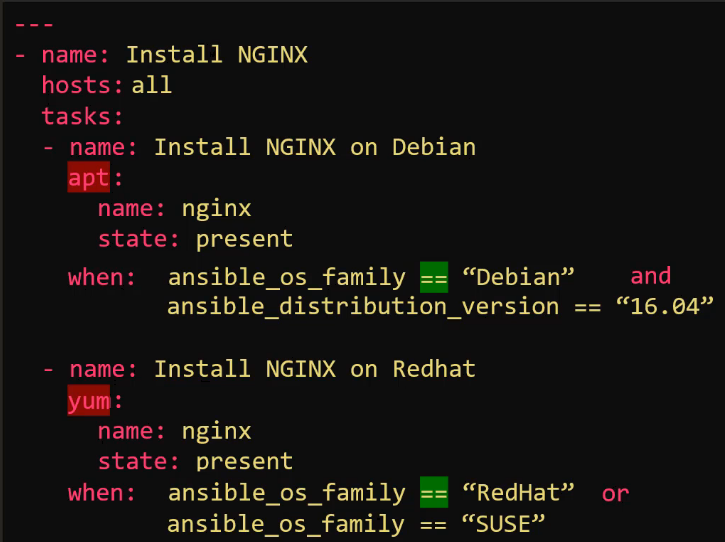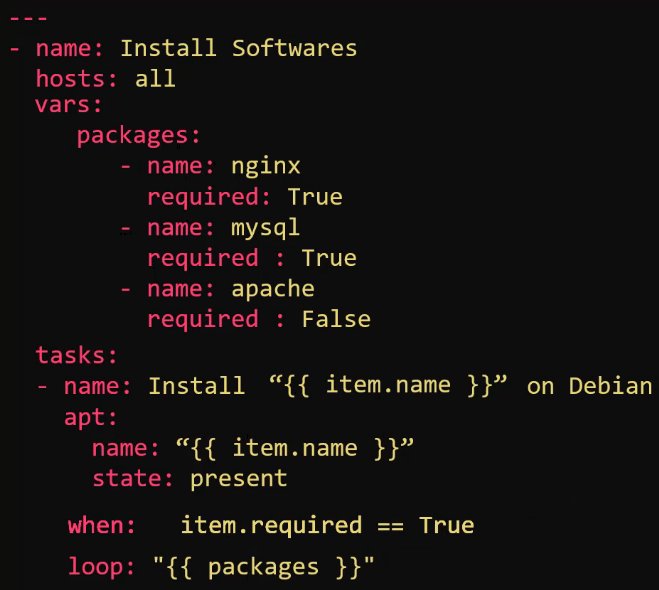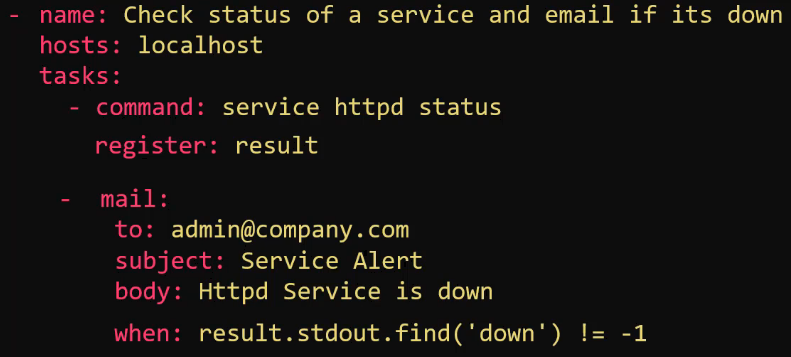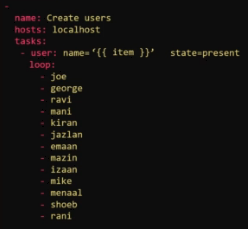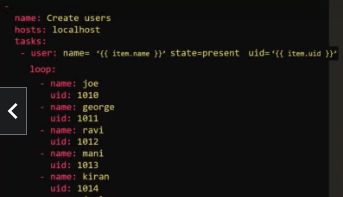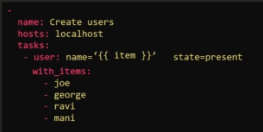5.0 - Ansible Playbooks¶
05.1 - Ansible Playbooks¶
Notes¶
- Playbooks are configuration files used to help Ansible understand what it needs to do when running.
- Example - Running commands on particular servers in a particular order, then restarting said servers in a particular order.
- Or more complex operations e.g.:
- Deploy x VMs to environment 1
- Deploy y VMS to environment 2
- Provision storage to all VMs
- Setup Network Configuration for all VMs in environment 2
- All Playbooks are written in YAML
- They contain "plays" - a set of activities (tasks) to be run on hosts
- Task - any action to be executed on the host e.g. run a script, install a package.
- Example Playbook:
- name: Play 1
hosts: localhost
tasks:
- name: Execute command "date"
command: date
- name: Execute script on server
script: test_script.sh
- name: Install httpd service
yum:
name: httpd
status: present
- name: start web server
service:
name: httpd
state: started
- Each activity will occur in the order that they are defined on the host defined
- The host must be included in the associated ansible inventory file e.g. localhost, server1.company.com
- All connection information must be specified in the inventory files
- Additionally, if a group is defined as the host, then all hosts in that group will be applied by default
- Playbooks = list of dictionary in YAML
- Each play is a dictionary
- Tasks are lists / arrays → ordered collection, meaning the order MATTERS
- The actions ran by tasks are modules e.g. command, script, yum, service
-
Further information provided in the ansible docs OR
yaml ansible-doc -l
- To execute an ansible playbook:
ansible-playbook <playbook>.yaml
05.2 - Demo: Run Ansible Playbooks¶
Notes¶
- When running ansible playbooks, generally have two options:
- using the ansible command
- using the ansible-playbook command
-
The former is typically used in an imperative manner for one-off commands not requiring a playbook e.g.:
```yaml ansible
-a ansible all -a "/sbin/reboot"
ansible
-m ansible target1 -m ping ```
-
The latter should be used when wanting to run a particular playbook. This is in a declarative manner.
ansible-playbook <playbook name>
Demo¶
- In the demo project folder created previously, run the following:
ansible all -m ping -i inventory.txt
- This will tell ansible to call the ping module to test connection
- Note: The all group is not specified in the inventory file, however it is created by default via ansible when specifying a particular inventory file.
- The same result could be achieved by a yaml file
- name: Test Connectivity to Target Servers # name of playbook
hosts: all # what hosts should this playbook apply to?
tasks:
- name: Ping Test
ping: # note the ping module doesn't require any parameters
- This can then be ran by the following:
ansible-playbook playbook-pingtest.yaml -i inventory.txt
Labs¶
Q1¶
Update name of the play to Execute a date command on localhost
-
name: 'Execute a date command on localhost'
hosts: localhost
tasks:
-
name: 'Execute a date command'
command: date
Q2¶
Update the task to execute the command cat /etc/hosts
and change task name to Execute a command to display hosts file
-
name: 'Execute a command to display hosts file on localhost'
hosts: localhost
tasks:
-
name: 'Execute a command to display hosts file'
command: cat /etc/hosts
Q3¶
Update the playbook to add a second task. The new task must execute the command cat /etc/hosts
and change new task name to Execute a command to display hosts file
-
name: 'Execute two commands on localhost'
hosts: localhost
tasks:
-
name: 'Execute a date command'
command: date
- name: 'Execute a command to display hosts file'
command: cat /etc/hosts
Q4¶
We have been running all tasks on localhost. We would now like to run these tasks on the web_node1. Update the play to run the tasks on web_node1
-
name: 'Execute two commands on localhost'
hosts: web_node1
tasks:
-
name: 'Execute a date command'
command: date
-
name: 'Execute a command to display hosts file'
command: 'cat /etc/hosts'
Q5¶
Refer to the attached inventory file. We would like to run the tasks defined in the play on all servers in boston
Inventory:
## Sample Inventory File
## Web Servers
sql_db1 ansible_host=sql01.xyz.com ansible_connection=ssh ansible_user=root ansible_ssh_pass=Lin$Pass
sql_db2 ansible_host=sql02.xyz.com ansible_connection=ssh ansible_user=root ansible_ssh_pass=Lin$Pass
web_node1 ansible_host=web01.xyz.com ansible_connection=ssh ansible_user=administrator ansible_ssh_pass=Win$Pass
web_node2 ansible_host=web02.xyz.com ansible_connection=ssh ansible_user=administrator ansible_ssh_pass=Win$Pass
web_node3 ansible_host=web03.xyz.com ansible_connection=ssh ansible_user=administrator ansible_ssh_pass=Win$Pass
[db_nodes]
sql_db1
sql_db2
[web_nodes]
web_node1
web_node2
web_node3
[boston_nodes]
sql_db1
web_node1
[dallas_nodes]
sql_db2
web_node2
web_node3
[us_nodes:children]
boston_nodes
dallas_nodes
Answer:
-
name: 'Execute two commands on web_node1'
hosts: boston_nodes
tasks:
-
name: 'Execute a date command'
command: date
-
name: 'Execute a command to display hosts file'
command: 'cat /etc/hosts'
Q6¶
Create a new play named Execute a command to display hosts file contents on web_node2 to execute cat /etc/hosts command on second node web_node2 and name the task Execute a command to display hosts file.
Refer to the attached inventory file (see Q5)
-
name: 'Execute command to display date on web_node1'
hosts: web_node1
tasks:
-
name: 'Execute a date command'
command: date
-
name: 'Execute a command to display hosts file contents on web_node2'
hosts: web_node2
tasks:
-
name: 'Execute a command to display hosts file'
command: cat /etc/hosts
Q7¶
You are assigned a task to restart a number of servers in a particular sequence. The sequence and the commands to be used are given below. Note that the commands should be run on respective servers only. Refer to the inventory file and update the playbook to create the below sequence.
Note: Use the description below to name the plays and tasks.
Stopthewebservices on web server nodes -service httpd stopShutdownthedatabaseservices on db server nodes -service mysql stopRestartallservers (web and db) at once -/sbin/shutdown -rStartthedatabaseservices on db server nodes -service mysql startStartthewebservices on web server nodes -service httpd startWarning: Do not use this playbook in a real setup. There are better ways to do these actions. This is only for simple practise.
Inventory:
## Sample Inventory File
## Web Servers
sql_db1 ansible_host=sql01.xyz.com ansible_connection=ssh ansible_user=root ansible_ssh_pass=Lin$Pass
sql_db2 ansible_host=sql02.xyz.com ansible_connection=ssh ansible_user=root ansible_ssh_pass=Lin$Pass
web_node1 ansible_host=web01.xyz.com ansible_connection=ssh ansible_user=administrator ansible_ssh_pass=Win$Pass
web_node2 ansible_host=web02.xyz.com ansible_connection=ssh ansible_user=administrator ansible_ssh_pass=Win$Pass
web_node3 ansible_host=web03.xyz.com ansible_connection=ssh ansible_user=administrator ansible_ssh_pass=Win$Pass
[db_nodes]
sql_db1
sql_db2
[web_nodes]
web_node1
web_node2
web_node3
[all_nodes:children]
db_nodes
web_nodes
Answer:
-
name: 'Stop the web services on web server nodes'
hosts: web_nodes
tasks:
-
name: 'Stop the web services on web server nodes'
command: 'service httpd stop'
-
name: 'Shutdown the database services on db server nodes'
hosts: db_nodes
tasks:
-
name: 'Shutdown the database services on db server nodes'
command: 'service mysql stop'
-
name: 'Restart all servers (web and db) at once'
hosts: all_nodes
tasks:
-
name: 'Restart all servers (web and db) at once'
command: '/sbin/shutdown -r'
-
name: 'Start the database services on db server nodes'
hosts: db_nodes
tasks:
-
name: 'Start the database services on db server nodes'
command: 'service mysql start'
-
name: 'Start the web services on web server nodes'
hosts: web_nodes
tasks:
-
name: 'Start the web services on web server nodes'
command: 'service httpd start'
5.3 - Verifying Playbooks¶
Check Mode¶
- This is ansible's dry-run mechanism, that attempts to run the playbook without making any actual changes on the hosts.
- Achievable via appending the
--checkflag when executing anansible-playbookcommand. - Not all modules support this option
Diff Mode¶
- When used in combination with check mode, provides a before-and after comparison of playbook tasks.
- This helps to understand and verify the impact of tasks pre-application.
- Add the
--diffflag to theansible-playbookcommand to use.
Syntax Check¶
- Ansible has built-in syntax check mode, simply add the folliwing flag:
--syntax-check
5.4 - Ansible-Lint¶
Overview¶
- Playbooks can become increasingly complex over time, leading to increased likelihood of deviation from best practice.
- Ansible-lint aims to mitigate these issues, this is a CLI tool that performs linting on ansible playbooks, roles, and collections.
- The tool checks code for potential errors, bugs, stylistic errors and deviations from best practice.
- To use:
ansible-lint <yaml file> - Output provides guidance on any errors it finds and the locations of the incidents.
08.1 - Conditionals¶
Introduction¶
- Consider two Playbooks that look to install NGINX, but one on Red Hat, another on Debian. This requires the use of the yum and apt packages respectively.
- Rather than have two separate playbooks for this same task, it's more advisable to bring the task into one playbook and use a conditional to perform the appropriate module.
- Conditionals are typically used via "when" statements e.g.:
- And and Or separators can be used for multiple conditions
- Conditionals may also be used in loops, an example follows, where the packages will only be installed if required is set to true:
- Conditionals can also be used in conjunction with the outputs of prior tasks, this would require the use of the register module.
- The example causes a mail message to be sent to the email address provided only if the httpd service is shown to be down
Conditionals based on Facts, Variables, Re-Use¶
- If tasks need to be ran depending on specific conditionsm such as OS architecture,
ansible_factscan be utilised in combination with thewhen:for conditionals. - Example, only run a task on hosts running Ubuntu 18:
when: ansible_facts['os_family'] == 'Debian' and ansible_facts['distribution_major_version'] == '18' - If wanting to run particular tasks using variables, use
vars:in a similar manner to below for the given task:
- name: deploy configuration files
template:
src: "{{ app_env }}_config.j2"
dest: "/etc/myapp/config.conf"
vars:
app_env: production
- For follow-on tasks for a play, you can then add
when: <var name> == '<var value>'after the variable was defined previously e.g. at CLI-level.
08.2 - Coding Exercise: Conditionals¶
Q1¶
The given playbook attempts to start mysql service on all_servers. Use the when condition to run this task if the host (ansible_host) is the database server.
Refer to the inventory file to identify the name of the database server.
-
name: 'Execute a script on all web server nodes'
hosts: all_servers
tasks:
-
service: 'name=mysql state=started'
when: ansible_host == 'server4.company.com'
Q2¶
The playbook has a variable defined - age
. The two tasks attempt to print if I am a child or an Adult. Use the when conditional to print if I am a child or an Adult based on weather my age is < 18 (child)
or >= 18 (Adult)
-
name: 'Am I an Adult or a Child?'
hosts: localhost
vars:
age: 25
tasks:
-
command: 'echo "I am a Child"'
when: 'age < 18'
-
command: 'echo "I am an Adult"'
when: 'age >= 18'
Q3¶
The given playbook attempts to add an entry into the /etc/resolv.conf file for nameserver.
First, we run a command using the shell module to get the contents of /etc/resolv.conf file and then we add a new line containing the name server data into the file. However, when this playbook is run multiple times, it keeps adding new entries of same line into the resolv.conf file.
- Add a
registerdirective to store the output of the first command to variablecommand_output - Then add a
conditionalto the second command to check if the output contains the name server (10.0.250.10) already. Usecommand_output.stdout.find(<IP>) == -1
Note: A better way to do this would be to use the lineinfile module. This is just for practice.
Note:
shellandcommandmodules are similar in that they are used to execute a command on the system. Howevershellexecutes the command inside a shell giving us access to environment variables and redirection using>>
-
name: 'Add name server entry if not already entered'
hosts: localhost
tasks:
-
shell: 'cat /etc/resolv.conf'
register: command_output
-
shell: 'echo "nameserver 10.0.250.10" >> /etc/resolv.conf'
when: 'command_output.stdout.find("10.0.250.10") == -1'
09.1 - Loops¶
Notes¶
- Loops allow the same command(s) to be ran iteratively to accommodate an ever-changing value(s)
- A common example is creating users
- Note: '{{ item }}' is used to call the loop iteration variable
- What happens if you have multiple sets of variables e.g. user name and user id
- Use a list of dictionaries in the loop
- Note: Would now refer to items in the list of dictionaries / arrays to call separate variables e.g.:
- item.name
- item.uid
- Note: The loop module is new to ansible, it was previously covered by the with_ module; an example follows:
- With_ allows more flexibilty compared to loops e.g.:
with_itemswith_fileswith_urlwith_env- These are all custom plugins primarily focused on lookup tasks.
09.2 - Coding Exercise: Ansible Loops¶
Q1¶
The playbook currently runs an echo command to print a fruit name. Apply a loop directive (with_items) to the task to print all fruits defined in the fruits
variable.
-
name: 'Print list of fruits'
hosts: localhost
vars:
fruits:
- Apple
- Banana
- Grapes
- Orange
tasks:
-
command: 'echo "{{item}}"'
with_items: '{{fruits}}'
Q2¶
To a more realistic use case. We are attempting to install multiple packages using yum module.The current playbook installs only a single package.
-
name: 'Install required packages'
hosts: localhost
vars:
packages:
- httpd
- binutils
- glibc
- ksh
- libaio
- libXext
- gcc
- make
- sysstat
- unixODBC
- mongodb
- nodejs
- grunt
tasks:
-
yum: 'name={{item}} state=present'
with_items: '{{packages}}'

